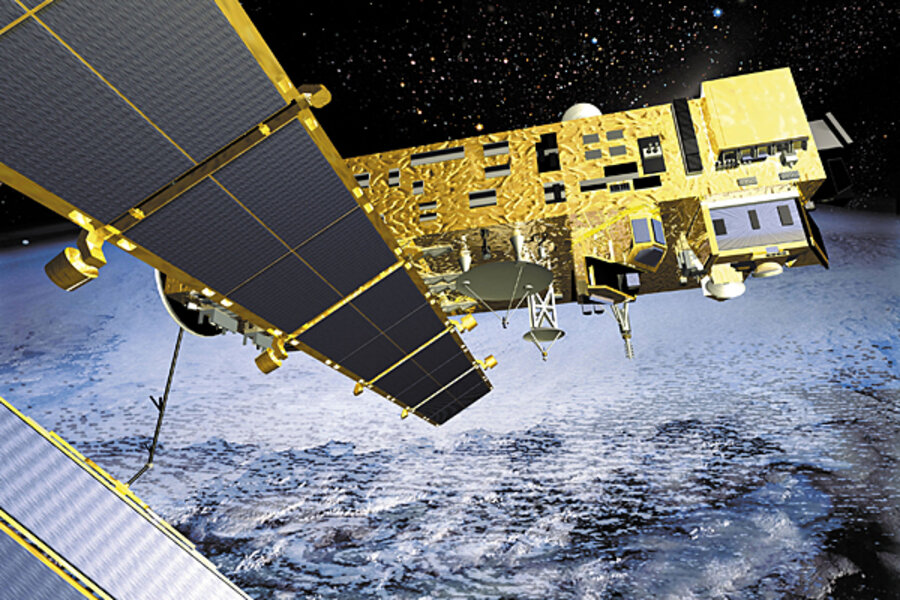Huge retired satellite will pose collision threat for next 150 years
Loading...
| Bremen, Germany
In three years, the European Space Agency will become the owner of what is possibly the most dangerous piece of space debris circling the Earth for the next 150 years: the 17,636-pound Envisat Earth observation satellite.
The space agency will take control of the Envisat satellite, which has been extended to 2013 and appears to set records wherever it goes.
Launched in 2002, Envisat was the biggest non-military Earth observation satellite ever built. At $2.9 billion in today's dollars, it is one of the most expensive. Its mission is viewed as a success by its users, all the more so insofar as the original five-year mission has been stretched to 11 years.
And now, once in retirement and in a near-polar orbit at 486 miles (782.4 km) in altitude, Envisat will become what space debris experts say is a huge problem that will not go away for about 150 years. That is how long it will take for Envisat, given its orbit and its area-to-mass ratio, to be gradually pulled into the Earth's atmosphere. [Most Memorable Space Debris Events]
Big satellite, big threat
Space debris experts attending the 38th Congress of the Committee on Space Research (Cospar) here July 18-25 said an event last January brought home just how much of a threat to the low-Earth orbit environment Envisat will be. That was when the U.S. Space Surveillance Network warned ESA that a 3,306-pound (1,500-kg) upper stage from a Chinese rocket was bearing down on Envisat and that the "conjunction assessment" pointed to a likely impact.
With Envisat still operational, ESA's European Space Operations Centre (ESOC) control facility in Darmstadt, Germany, fired Envisat's on-board thrusters to perform a collision avoidance maneuver.
Heiner Klinkrad, head of ESA's space debris office at ESOC, said here July 21 that a post-event analysis showed that the Chinese stage probably would have collided with Envisat if the avoidance maneuver had not been done. Such maneuvers will not be possible once Envisat is retired.
ESA officials, more accustomed to speaking of Chinese, Russian or American debris issues, are uncomfortable discussing the danger that Envisat represents, especially since the agency has showcased the satellite as a major success.
Klinkrad is no exception. But he did say that if the collision with the spent Chinese upper stage had occurred, it likely would have polluted a highly used portion of low Earth orbit with 10 times as much junk as what was caused by the 2009 collision of an operational Iridium communications satellite with a retired Russian Cosmos spacecraft. That event occurred at about the same altitude where Envisat flies.
Huge satellite debris risks
Envisat's 17,636-pound (8,000-kg) mass alone would be enough to put it onto the top tier of space debris threats, even though there are nearly a dozen spent Russian rocket upper stages that weigh as much as or more than Envisat.
But Envisat's configuration in orbit makes it a unique concern, even beyond its weight. The satellite's in-orbit size is 26 meters by 10 meters by five meters. Its suite of observing instruments uses a small farm of antennas that likely have become more fragile after a decade in orbit. That means that even a small piece of debris — pieces too small to be cataloged by the Space Surveillance Network — could cause what debris specialists refer to as a "fragmentation event" that would produce its own population of space garbage.
An analysis of the space debris environment at Envisat's orbit suggests that there is a 15 percent to 30 percent chance of the satellite colliding with another piece of junk during the 150 years it remains in orbit. But that likelihood is based on the current population of space debris in low Earth orbit remaining constant during the period — a scenario no one believes is remotely possible.
NASA's assessment is that even if the world's space-faring nations stopped all launches today, the debris population in low Earth orbit would continue to increase for half a century as collisions increase the population faster than the natural cleansing effect of atmospheric drag.
Envisat program managers say that for many reasons, including industrial policy and overall program costs, Envisat was built with a fuel tank used by the French Spot 4 optical Earth observation satellite, whose launch weight was less than half of Envisat's.
With such a small fuel tank, any attempt to bring the satellite's orbit down to where it could re-enter the atmosphere would have meant retiring Envisat just a few months after its launch.
ESA officials insist that the international guidelines on disposal of debris were not in force when Envisat was designed.
Too big to fall?
Further complicating Envisat's post-retirement status is that the satellite is too big to be allowed to drift into the Earth's atmosphere. Emerging European space safety regulations require that space hardware big enough that large chunks will survive atmospheric re-entry must be guided so that they enter the atmosphere over uninhabited areas, such as the South Pacific.
Jurgen Starke of Astrium Space Transportation, whose company is under ESA contract to study debris removal technologies, said current French law — France has jurisdiction over Europe's Guiana Space Center spaceport — requires that the likelihood of re-entering the atmosphere over a populated area not exceed 1-in-10,000.
Starke said here July 21 that Astrium is still uncertain whether, in Envisat's case, it would be better to raise the satellite to an orbit that currently is unused, or to guide it into the Earth's atmosphere over the Pacific Ocean. In either case, a mission would cost several hundred million dollars including launch, he said. For the moment, neither scenario is likely to be approved by ESA governments.
Most Memorable Space Debris Events
Zombie Satellite Forces More Evasive Maneuvers for Other Craft





